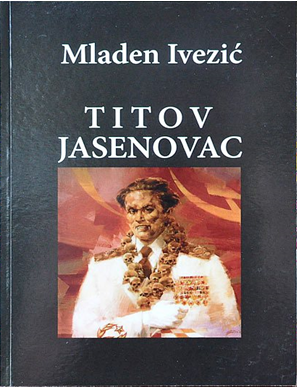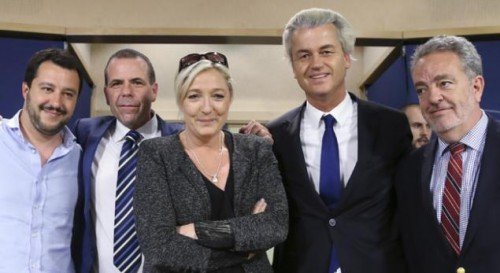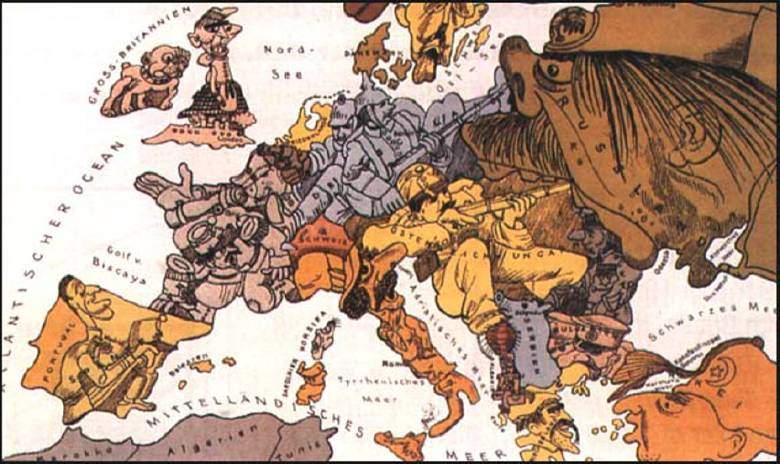Translated from the Croatian by the author 
The following is the English translation of a video of my speech at the conference at the prestigious Jesuit center in the capital of Croatia, Zagreb, on May 22. The conference was held on the occasion of the recently published book, Titov Jasenovac (2014) by a Croat historian Mladen Ivezic. Jasenovac is a location in Croatia that is frequently associated by antifascists and procommunist scholars with the alleged mass killings of hundreds of thousands Communists, Serbs and Jews during WWII by the pro-fascist Croat nationalists, i.e. the “Ustashas.” The event was attended by many prominent Croat nationalists, survivors of communist camps and many other public figures, including a number of Catholic clerics and a local bishop.
Ivezic rejects body counts put forward by the former communist Yugoslav government and offers a substantial bibliography on how the camp of Jasenovac was used instead, in the aftermath of WWII, by victorious Yugoslav communists for their mass killings of imprisoned nationalist and anticommunist opponents. He shows that subsequently, the Yugoslav communists attributed the overall number of the killed at the Jasenovac camp as the work of the defeated local Croat fascists.
The official number of the pro-fascist Croat Ustashi victims has wildly varied ever since: from 700,000 victims, claimed during the communist period in ex-Yugoslavia, to the official 70,000 victims in contemporary Croatia, with more and more attempts at downsizing the number of the camp victims.
The issue of Jasenovac puts very serious strains on the relationship between Serbs and Croats. Moreover, the symbol of the Jasenovac camp reflects not just deep divisions between the so-called antifascists and nationalists in today’s Europe but also points to very serious and highly inflammable rifts between and among all European nationalists. Following the recent electoral success of nationalist parties in Europe, it would be foolish, naive and dangerous to fantasize about some “common White European homeland,” having in mind the radically conflicting “cultural memories” of all European peoples. The case in point is that time and again, as in modern Ukraine, there are two mutually exclusive visions of its future by pro-Russian and Ukrainian nationalists respectively.
* * *
A good portion of Croatia’s modern historiography, covering the period from 1941 to 1945, can be described as an exercise in the antifascist demonology. Such historiography rests on a poor empirical basis. It should be borne in mind that modern historiography, just as the study of other fields in social sciences, is still subject to specific historical and political circumstances, especially the military victory of the Allies over the Axis forces in 1945. Without Stalin and the Communists, the Western Allies would have never won World War II. Without Roosevelt and the capitalist America, the Soviet Union and Stalin would not have won World War II. Without the help of the Allied British and Americans, the Yugoslav Communist Josip Broz Tito and his Party would have never come to power in communist Yugoslavia.
Of course, Auschwitz was liberated by the Red Army in late January 1945, although the same Red Army forces, five years earlier, had secretly murdered thousands of Polish officers in the Katyn forest. On its way to Auschwitz, the Red Army had murdered and expelled millions of German civilians — from the Baltic states to Silesia. Modern historiography, taught at universities across America and Europe, has not only a pedagogical purpose, but also serves to demonize political opponents in order to better conceal its own home-grown skeletons in the closet. Moreover, each historiographical demonology is accompanied by an oppositional victimology teeming with a subjective and hypermoralistic narrative whose prime purpose is to highlight one’s own body counts while diminish the other.
Fascist Bestiary
Fascist snakes, fascist serpents, fascist dragons, and the whole arsenal from the fascist bestiary were always at hand in former communist Yugoslavia, because this was the surest way for communist Yugoslavia to justify its existence. Today, a significant number of historians and journalists in Croatia continue to resort to the same arsenal of the fascist bestiary. However, the unofficial Croatia — the Croatia that exists apart from political, media and academic elites — rejects this bestiary because it reminds her of hard times in former communist Yugoslavia. The old political rule comes again to light: there is a legal Croatia; but there is also a legitimate Croatia, each with its own symbols, its own demonology and its own conflicting and exclusive victimhood. The question needs to be raised: Can the modern global system and its extension in the new political class in Zagreb survive without its antifascist demonology, without its Jasenovac camp, without its demon Ante Pavelic— and without the timeless demon Adolf Hitler?
Each historical event is unique, single and cannot be repeated. But in the present age of transformational changes across Europe, the historian interprets each historical event based on his own ethnic, ideological and theological pedigree. The first conclusion we must draw is that before we read history, we must first read the historian. We must ask: What are the historian’s motives for such and such approach to a historical subject matter, or in our case the body counts of Croatia’s Jasenovac and the Croatian Bleiburg? Jasenovac was a pro-fascist Ustasha concentration camp; Bleiburg was a communist killing field — not a concentration camp. From the technical point of view, each political concentration camp, anywhere in the world, in any political regime, at any historical epoch, is not designated for immediate destruction of prisoners, but rather for their slave labor. If it were not so then concentration camps would cease to exist. Our second conclusion is therefore of legal and logistical nature; war crimes are not the same as crimes committed in the aftermath of war or crimes beyond the battle lines. Prison camps are not the same as nameless graves, abandoned mine shafts, ravines and pits for which we still have little documentation available.
Demonological, mythological, criminological, and pathological approach to recent Croatian history constituted the core of the former Yugoslav identity, but also formed the legal crux of antifascist Yugoslavia. The distorted communist historiography was the main cause of the breakup of Yugoslavia and the ensuing war against the newly formed Croatian state 1991. In the light of recent historical research, based to some extent on forensic investigations, as well as access to archives, the former Yugoslav antifascist historiography is beginning to show cracks, and as time elapses, it takes on hagiographical and science fictional traits.
It is interesting to note that when antifascist historiography becomes empirically untenable, it begins assuming “civil-religious” traits, as is the case today all over Europe. These new “civil-religious” traits reject and often legally censor any critical reassessment of the history of WWII. The best example again is the case of former Yugoslavia before its dissolution. The media and the intellectual war between Croatian and Serbian historians and journalists had been in full swing regarding both the victims of the Jasenovac camp and Bleiburg — a verbal war of historical memories that inevitably spilled over into real armed conflict in 1991. The symbolism of Jasenovac and Bleiburg had a different meaning for a Serb peasant living near the Croat town of Sisak, a completely different meaning for a Croat peasant living in the same vicinity, and a completely different meaning for a former Croatian émigré living in the vicinity of Santiago, Stuttgart or Sydney.
Demons, ghosts, snakes, evil spirits, witches, beasts, devils and monsters, were negative images used by the former regime-sponsored Yugoslav antifascists for the personification of the pro-fascist Ustasha government during WWII. In a similar fashion modern day antifascists use similar labels to depict their right-wing nationalist opponents. Seventy years after the end of World War II and nearly 25 years after the founding of modern Croatia, the identity of the Croatian state remains fragile. On the one hand we are witnessing the demonological, snake-like, criminogenic and pathogenic Croat identity, largely instilled by world-wide antifascist propagandists, mythographers, and demonologists; on the other hand, there is a considerable number of domestic victimological Croats who condense their entire identity into to pronounced anti-Serbianism, and to posthumous-commemorative obituaries of their own victims only.
Killing Sprees
This is nothing new. Demonology in regard to the “Other” carries always its counterpart — its own self-serving victimology. After all, the henchman has his own victimhood — for himself and his family. And each victimhood, including the Croat victimhood in regard to Bleiburg, has ultimately — and unfortunately — a vindictive side. The Croat dead in the aftermath of May 1945, be they victims of the Bleiburg killing fields or those at Tito’s post-WWII Jasenovac, did not fall from the sky; those victims were caused by somebody, and that ” somebody,” or that “Other,” or his children, still live in Croatia today .
The entire classical literature is full of ghosts, demons and evil deities, with even the heroes turning into henchmen, as was the case with Siegfried and Hagen in the Nibelungenepic, or Hector and Achilles in Homer’s Iliad, or our well-known Western neurotics with suicidal fantasies, like Faust and Hamlet. The ancient god of the underworld, Hades delivered only one way tickets for politically incorrect characters who had dared to defy the rites of their times. The guardian of the Hades underworld was Cerberus, a three-headed political dog with a snake tail — one could almost say a forerunner of the future Bolshevik commissar, very similar in looks to the Yugoslav communist Moshe Pijade. \
Hell awaits all — both good men and bad men, especially when a good man loses a sense of the tragic and begins raving about how historical times must come to an end. Even our cherished heroes like Odysseus and Agamemnon, after they had burned down Troy and killed the young and old of the city, experienced in their turn a terrible fate. Ulysses’ crew members, after a decade of wandering through the rough seas, were eaten alive by Cyclops. The powerful king Agamemnon, on his return to home sweet home, was ambushed and butchered by his own wife. Their son, the hero Orestes underwent torments by the furies, the goddesses of revenge, because he had avenged his father by killing his own mother Clytemnestra, who had previously killed his father — her legitimate husband.
It is futile to debate with modern demonologists the veracity or mendacity of WW II body counts or attempt to provide empirical or forensic evidence regarding diverse victimhoods. All of us rightly clamor that ” victims, regardless of their size and number deserve respect.”
Agreed. And this regardless of whether the figure of the dead in the pro-fascist Ustasha camp of Jasenovac was 700,000 or 70,000 or 7,000 or 700 dead! If we were to accept the 700 figure, as put forward by the author of this book, the difference is in 699,300 lives — which is no small thing for a small Croatia, let alone for the great mythical Homeric stories, and let alone for the antifascist demonology!
Demonology is a matter of faith, a kind of collective mystique, just like today’s democratic mystique about the everlasting European Union and limitless economic growth. It is naive to believe that the modern antifascist demonology, including the hagiographical tales about the Second World War, can be disputed by facts. And even when such antifascist demonology becomes outmoded, another one will spring up in its place. Demonologies have always been around, ever since the beginning of time, irrespective of the period of the Enlightenment. In fact, the period of the Enlightenment in the 18th century ushered in its own dangerous myths: the myth of progress and the myth of permanent economic growth. If by chance somebody today ventures to voice his disapproval of today’s modern myths, such as the myth of liberal democracy, the myth of multiculturalism, the myth of parliamentarianism, the myth of coexistence between peaceful peasants and pristine pederasts promoted by the LGBT lobby, he will likely be declared insane by the System.
Not long ago a large number of historians in today’s Croatia were avid spokesmen of the Communist demonology only to become today avid supporters of the American liberal mystique. What must be of our concern are not their communist bygone times but rather how quickly they recycled their former beliefs. Tomorrow, when new demonologies set in, they will swiftly start praying to new gods and bow down before new lares and penates.
Dr. Tom Sunic is a member of the Board of Directors of the American Freedom Party. His new book Chroniques des temps postmodernes (Avatar, 2014) has just been released.







